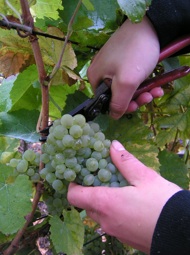
Features
Production
Research
Grape harvest continues in Nova Scotia
November 4, 2008 By The Canadian Press
 November 4, 2008, Habitant, N.S. – As colder temperatures settle in across Nova Scotia’s Annapolis Valley,
November 4, 2008, Habitant, N.S. – As colder temperatures settle in across Nova Scotia’s Annapolis Valley,
Racca Vineyard owner Allan MacIntyre is hurrying to harvest his prized
Cabernet Franc grapes.
November 4, 2008, Habitant, N.S. – As colder temperatures settle in across Nova Scotia’s Annapolis Valley, Racca Vineyard owner Allan MacIntyre is hurrying to harvest his prized Cabernet Franc grapes.
 The grapes will be the last variety picked this year at the 4.7-hectare vineyard.
The grapes will be the last variety picked this year at the 4.7-hectare vineyard.
Family, friends and neighbours pitch in to bring in the grapes. About half the crop is harvested by hand, the other half mechanically.
“They are tough to grow and later-ripening,” MacIntyre said. “This variety has been trained low on the vines.”
The vines, currently about eight years old, have a 30-year life span.
It’s been a challenging season for grapes in Nova Scotia. With so much rain this year, fungal diseases have been an issue and the fruit has to be protected. Temperatures have also been generally low, and October seems to have been cooler than in recent years.
But MacIntyre says the vineyard’s location helps.
“We have a pretty good site here,” he says. “The frost seems to come a little later and I think the close proximity to the water moderates the temperature a bit. We still have nice flavour groups even though the sugar is a bit lower in the grapes.”
Racca Vineyard grapes go to Jost Vineyards in Malagash, where Hans Christian Jost has become a major buyer of Nova Scotia grapes.
“It was a huge harvest this year. We ended up with surprisingly pleasant sugars,” Jost says. “With three new wineries open, we now get 75 per cent of our grapes from Nova Scotia, and that number is steadily increasing.”
The Annapolis Valley supplies close to 60 per cent of Jost’s harvest.
“Growing grapes is extremely labour-intensive, and that’s definitely not getting any easier,” Jost says.
A number of wineries have mechanical harvesters, which do about half the harvest. Other equipment is coming in and being shared by wineries.
Jost has produced ice wines since 1985 and a new sparkling wine this year has been a big hit. The Nova Scotia Liquor Commission has been taking on more Nova Scotia wines, giving consumers more choice.
“It’s amazing how the popularity of Nova Scotia wines has gone up as the number of wineries has increased,” Jost said.
“Now there are 11 wineries in this province open to the public. We are promoting the idea of having 18 to 20 wineries here over the next 10 years.”
Print this page